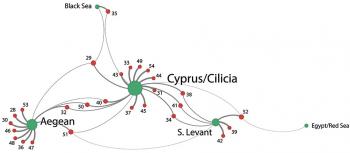American Journal of Archaeology | The Journal of the Archaeological Institute of America
You are here
From Time Capsules to Networks: New Light on Roman Shipwrecks in the Maritime Economy
October 2017 (121.4)
From Time Capsules to Networks: New Light on Roman Shipwrecks in the Maritime Economy
This article bridges two divergent traditions in the study of Graeco-Roman shipwrecks: analysis of single well-explored sites and growing databases of more cursorily documented wrecks. The critical insights and distinct advantages of depth or breadth underscore the complementarity of these approaches for investigations into the ancient economy, yet few syntheses offer a middle ground that capitalizes on the growing corpus of data without flattening the detail that can be gleaned from closer study of maritime assemblages. The methodology here offers one potential path forward, combining, on the one hand, insights gained from wreck quantification into the ebb and flow of long-term connections with, on the other hand, network analysis visualization of cargoes to highlight structural patterns in those connections. With a data set of 54 shipwrecks spanning the second century B.C.E. through the seventh century C.E., southwest Turkey presents a rich case study through which to examine long-term trends in the maritime economy between the Roman world and late antiquity. Beyond immediate insights into seaborne exchange in one period and one corner of the ancient Mediterranean, this multifaceted approach aims to increase the interpretive utility of ongoing underwater survey and the crucial but often uneven primary data it offers for maritime connectivity.
From Time Capsules to Networks: New Light on Roman Shipwrecks in the Maritime Economy
By Justin Leidwanger
American Journal of Archaeology Vol. 121, No. 4 (October 2017), pp. 595–619
DOI: 10.3764/aja.121.4.0595
© 2017 Archaeological Institute of America


